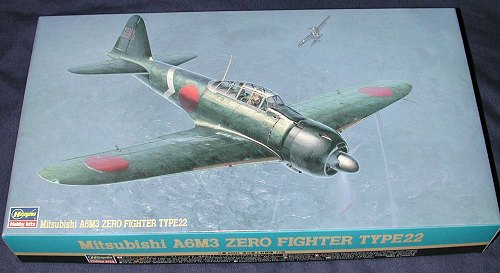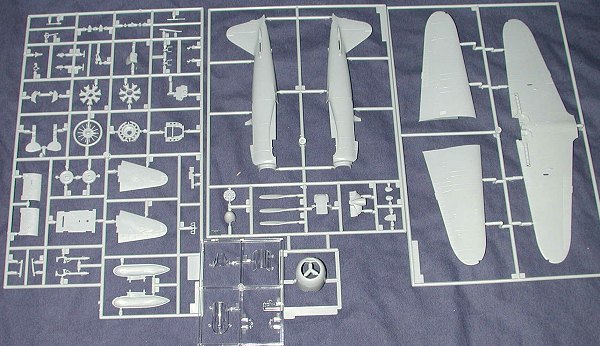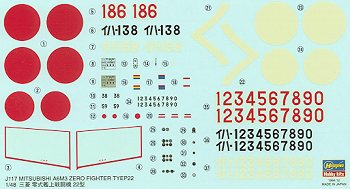
|
KIT: |
Hasegawa 1/48 A6M3 type 22 Zero |
|
KIT # |
09117 (JT 17) |
|
PRICE: |
$26.98 MSRP (Not in 2004 catalogues) |
|
DECALS: |
Three options |
|
REVIEWER: |
Scott Van Aken |
|
NOTES: |
1994 boxing |

|
HISTORY |
The A6M3 type 22 was actually built after the clipped wing type 32. Thanks to the additional power of the Sakae 21 engine over the previous Sakae 12, the Sakae 21 did not have the same fuel consumption as the earlier version. To add to that, the new engine was longer so the forward fuselage fuel tank had to be reduced in size. This meant that the type 32 was decidedly down on range. Thanks to the clipped wing, it also did not have the ceiling or rate of climb of the earlier A6M2 type 21, though it was faster and did have a greater roll rate.
To counter that, the type 22 reinstated the wing extension and also had increased fuel tankage added to the wings to make up for the thirstier engine and the loss of fuselage fuel stowage. Several type 22s had long barreled cannon fit into the wings at at least one was field tested with wing mounted 30mm cannon. Though not built in the kind of numbers that the later type 52 was, the type 22 served well during the middle years of the war and was the mount of many a JNAF ace.
|
THE KIT |

Hasegawa pretty well has the field for 1/48 Zeros. They box almost every known variant, including some rather rare types, like the A6M8. All use the same basic fuselage, cockpit and tail section as that was unchanged. They simply change the wings and the engine to match whatever version is being done.
This results in several inserts and add on bits that vary from one aircraft type to another. It also means that the main molds do a lot of service. My kit was boxed in 1994 (which was ten years ago) and even then it shows a bit of flash and some sink areas around alignment pins that were probably not there when first produced. As one expects from Hasegawa, the level of detail is quite good. There are lots of aftermarket bits for the Zero should you wish that additional level of detail, but most of us will be quite satisfied with what comes in the box. I especially like that there are instrument decals provided that fit perfectly over the various panels. Saves my having to paint these things and looks a ton better than I could ever do myself.
Options for the kit are quite limited. You basically have
the choice of leaving the canopy open or closed, attaching the drop tank
or not, or installing the tailhook. If you leave the hook off, there is a
cover plate that goes over that area. Often the hooks were removed if the
plane was not going to be land based for any extended period of time.
Instructions are excellent and give all colors in Gunze references. There are options for three aircraft: A 582nd Flying Group plane as shown on the box art. It is dark green over green-grey. Next is an overall green-grey Iwakuni Flying Group plane and another from the same unit in the green over green-grey scheme. All of them have the yellow ID stripes as mandated in 1943. Decals are typical of the time. They are well printed, thick and the white is actually ivory. They also provide multiple options for doing different aircraft of the three options provided, which is a nice touch. If you apply them with very hot water, no setting solution is needed. Indeed, some setting solutions will cause major problems with these older Hasegawa decals.
|
CONCLUSIONS |
Overall, it is an excellent model. They say that more Zeros are built than any other aircraft model and I can see where that could well be the case. I've built several of these Hasegawa Zeros in the past and I don't see any reason why I won't do more in the future.
If you would like your product reviewed fairly and quickly by a site that has nearly 250,000 visitors a month, please contact me or see other details in the Note to Contributors.